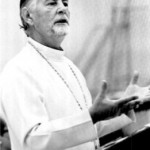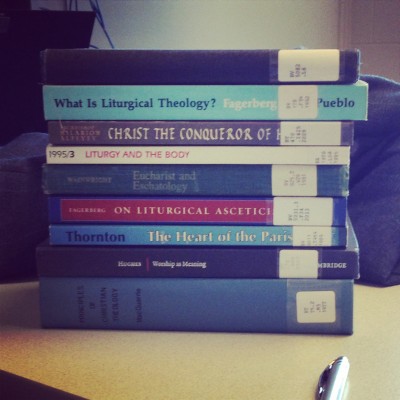This is the second of two sermons to be posted today in commemoration of the Feast of the Transfiguration. To God be the glory!
O God, who on the holy mount revealed to chosen witnesses your well-beloved Son, wonderfully transfigured, in raiment white and glistening: Mercifully grant that we, being delivered from the disquietude of this world, may by faith behold the King in his beauty; who with you, O Father, and you, O Holy Spirit, lives and reigns, one God, for ever and ever. Amen.
Surely you know by now that you need to be prepared for an adventure when I’m here to preach! Today is no exception. This morning we are hiking up and down a mountain. When we get to the top we will survey the landscape and the surroundings, but our journey is much like that of the disciples we read about: the walk up and down is as important as our time at the summit. As ever, you need to lace up your boots and put on your imagination caps – your memory of Israel’s story is extremely important. I’ll be here to point things out along the way, but I want you to really pay attention to the imagery and details of every word of our passage.
A quick note is that Luke, as with the other three gospel writers, was very fond of giving clues and strong hints in his writing. His stories are laced with traces, shadows and echoes of the Old Testament. For the gospels the Old Testament – obviously not called that in their day – was the interpretive matrix of their stories. What I mean is that the gospel writers weren’t writing in a vacuum. They were writing at the fulfillment and culmination of Israel’s story. When you read the gospels, therefore, you need to ask: is there any correlation in the OT to this story? For Luke the answer is almost always a resounding, “YES!”
Our story opens up with the comment, “8 days after these sayings.” What sayings? Well, Jesus asks the disciples his famous question, “Who do you say that I am?” Peter speaks up – surprise – and gets it right, “You are the Christ, the Son of the living God.” Jesus was the Christ, the Messiah, the Anointed One who had come to fulfill Israel. But the next statement is equally important: Jesus talks about the cost of following him. Why? Because Israel was expecting a Messiah who would come and restore them, end of story. Jesus had come to do this but he would do it as the suffering servant who would die on the cross. The disciples and Israel had no concept of that. Jesus warns his followers that following him is difficult. It is tough. It requires giving your entire life. Our story this morning piggyback’s on these statements.
Back to the story, here we encounter Jesus and the three. Who were the three? They were Peter, James and John. This was the inner circle of the twelve. We find these three with Jesus at some of his most important moments: the Transfiguration and praying in the Garden of Gethsemane right before his arrest. We should automatically assume that something important is going to happen when the text tells us these three were together.
Jesus and the three climb a mountain. This is where your imagination caps are necessary. Were mountains important to Israel at all? Some examples: Mt. Moriah where Abraham traveled with his only son Isaac in order to sacrifice him unto the LORD and yet the LORD intervened and provided the sacrifice instead; Mt. Sinai where Moses received the 10 commandments and communed with God; Mt. Neebo where Moses is able to glimpse the Promised Land but not enter; Mt. Carmel where Elijah battled and defeated the prophets of Baal. That Luke tells us Jesus and the three are climbing a mountain is another massive clue to those of us with Jewish imaginations and memories that something extremely important is going to happen.
Jesus wants to go and pray. Why? Because he is tired and wants to reconnect with the Father. Prayer is a very important theme in Luke. Luke uses prayer for Jesus at the transition into an important moment: baptism, selecting the 12 disciples, the transfiguration, being betrayed and arrested, on the cross. Peter has just revealed Jesus’ identity and we find out in this passage that his departure is imminent – Jesus needs to rest and be with this Father. When we read that Jesus wanted to pray we should also clue in that this is no ordinary mountain climb.
What is it that happens? Jesus is transfigured and appears in gleaming white. Mark says that Jesus’ face is radiant, but Luke says it is his entire person, including his clothes. Does this sound familiar? It should! When Moses went up to the top of Mt. Sinai to be with God, he would encounter God and then return to this people with his face radiant. His face was so radiant that he had to wear a veil to hide the light. Jesus’ transformed appearance is thus not merely because he is experiencing God’s glory (like Moses) but rather because he is the very source of divine glory. The point is made explicit when the three disciples are said to see Jesus’ glory in verse 32.
Not only did Jesus radiate with great light, he also appeared while talking with Moses and Elijah. What do you know about Moses and Elijah? Their identities, lives and ministries are important. Here is the cliff notes version. Moses was the deliverer of God’s people out of Egypt after 400 years of oppression; he was God’s chosen leader; he led the people across dry land in the Red Sea; he led them through the desert for 40 years; he had a relationship with God known to no one else; he received the 10 Commandments on behalf of the people; it was promised that one would come after him ever greater than he was. Elijah was a great prophet; he prophesied in Israel during a time when there were no other prophets or godly people; he defeated 800 prophets of Baal atop Mt. Carmel; he raised up a great leader in Elisha; he performed miracles; commonly known as the greatest of the prophets and he never died.So, are you seeing why it is significant that Jesus was talking to the two of them? There are two trains of though here and they are both important. The first says that Moses represents the Law and Elijah the prophets – which is the way that the Jewish Bible was divided. Therefore Jesus was greater than both of them and this pointed to his identity as Messiah. The second idea says that this experience at the mountaintop is a means of both looking back and forward, it is a turning point in Israel’s history. As such it makes sense that the two greatest leaders of Israel were present when Jesus was about to begin his journey toward the cross. For them the transfiguration was a peaky-boo at what things would be like forever in God’s kingdom. The transfiguration scene provides both a dramatic confirmation of Peter’s confession and a foretaste of the glory to be experienced when God’s kingdom is fully present.
What are Jesus and the two talking about? Jesus’ departure. His impending death at the hands of Rome and the Jewish leaders. His suffering on a cross though he was the Son of God. This is an important detail. This is, as I said, a great turning point in the story. For Luke this single moment – the Transfiguration – is the hinge upon which his Gospel turns because everything thus far has led up to this moment and at this point he begins his long trek toward Jerusalem, death and resurrection. The theme of suffering envelopes the transfiguration story. If people who heard Mark’s account wondered what Moses and Elijah were talking about with Jesus – for Mark does not tell us – Luke informs us: they were talking about Jesus’ ‘exodus’. What happened in the Exodus? God saved, redeemed and delivered his people – and now Jesus is going to do that once and for all.
The disciples had been sleeping up this point – an important foreshadow of when they would fall asleep in the Garden of Gethsemane though Jesus had asked them to pray. In Jesus’ hours of need the disciples didn’t always do too well. Peter wants to build tents/booths/tabernacles. Luke says that Peter didn’t know what he was saying, but there was SOME truth to it. Peter understood that they were in the midst of incredible holiness, just like the Tabernacle in the OT, and so building something was not entirely inappropriate. But the point is that the journey up required a journey back down and a journey toward a future.
In the midst of this incredible event a cloud descends. Now remember, God has revealed himself in a cloud before: the pillar of cloud led the Israelites by day, his presence surrounded Mt. Sinai like a great cloud, when he was present in the Tabernacle his presence was known in the form of a cloud. So, when the cloud descends atop the mountaintop with Jesus, Peter, John and James…we shouldn’t be left surprised at what’s happening. The Presence of God is enveloping them, as the Presence of God has done time and time again to God’s faithful people. This was God’s shekinah glory, that which transformed Moses’ face countless times during the exodus.
So the cloud is important, but so is the voice and the words spoken: God had spoken words like this already at Jesus’ baptism. There are two important parts to God’s words here. First, He again identified Jesus as his beloved son. Second, he is calling the disciples to listen to him. Jesus’ identity is still one of intimate relationship with the Father, but now he is authorized as someone to listen to. The rest of the book recounts Jesus’ move toward Jerusalem in preparation for his death and resurrection. The disciples did not understand what was to come, but God instructs them to listen. Are we listening?
The words from on high appear to include a phrase from Deuteronomy 18:20, where Moses predicts that a prophet like himself will arise and people should ‘Listen to him!’.
The disciples are struck silent. They are in awe. They aren’t quite sure of what they’ve just witnessed but they know it’s significant and holy. There are moments in our spiritual lives when praise and proclamation are important and there are other moments when we are left utterly silent, and this is good.
So what?
I’ve been using the imagery of journeying. As you begin brand new today or continue your journey with Jesus, why does the Transfiguration matter? So what does it mean?
It means three things: Assurance. Presence. Obedience.
ASSURANCE – The Father
He is good, but he isn’t safe. The disciples were in sure hands, faithful hands, loving hands, but it doesn’t mean that they were safe. What I want you to see is that Jesus is who he says he is and he will accomplish what he has promised. If you are looking for someone or something to put your faith and trust in then look at Jesus. Luke weaves so many themes and topics into his story that it is impossible to miss: Jesus is the Messiah, the promised one of Almighty God who has covenanted with his people and will redeem them once and for all. We are grafted into that covenant through Christ. If you have doubts or questions, that is okay – Jesus is a big boy and can handle it. Here is the answer to your question: Jesus holds water. Jesus works. Jesus is true. Jesus has his identity assured to us by his heavenly Father, the creator of the world.
PRESENCE – The cloud & silence
As Christians, we need to learn how to sit in the cloud. As Christian leaders, we need to teach our flocks to do the same. We need to teach patience, and how to be comfortable not knowing about something, but rather really knowing Something.
Moses came down from the clouded mountain with his face radiant—changed. Because it’s in the cloud that we’re changed.
Peter, James, and John are changed on that mountain—forever. And, not because they learned lots of fun-filled facts. In reality, they probably descended with more questions than answers.
But, like Moses, they met the Living God. And, that’s what changes us. That’s what alters the course of our lives. And, as Christians, that’s what we’re all about: being in God’s Presence.
In the midst of the moment when all is shining bright and Peter, like the rest of us,wants to hold on and build, God says LISTEN.
Be open. Receive. Don’t share yet. Don’t make this a forever. Forever is coming, but in ways that you can’t yet see. In the meantime, watch. Be aware. Keep your eyes on Christ. And receive.
OBEDIENCE – The Son
The message of Jesus’ sonship here is given an imperative implication: “Listen to him!” Jesus’ sonship is not a matter of abstract theology but requires the obedient response of the disciples to Jesus’ message. Jesus’ most recent teaching emphasized the costly demands made on those who would follow him, i.e. denying themselves and taking up their cross (verse 23), and that is surely the primary message meant to be listened to and obeyed here.
The command to listen to him is also a reminder of the earlier invitation offered by Jesus to follow him. When we follow we listen. We don’t obey Jesus because he is a totalitarian leader but because he is good, because he is loving, and because he guides us faithfully.
Friends, the Christian life is indeed a journey with Jesus. We travel up mountains, often wondering why the trek is worth it or will we ever clear the tree line and see breathtaking landscapes. The answer is yes, but sometimes we miss the beautiful foliage and the intricacy of God’s good creation around us. We miss his glory and holiness in the midst of our lives. I want each of you to pray this week that God would reveal his glory to you. That you would be left wonderstruck by your creator. The summit is always important – in our mountaintop moments with the Lord we are transformed in our holy encounters. But, if we can learn anything from Peter, the transformation is not to be lived out at the top of the mountain, in isolation from the world. No, we are transformed to then walk back down the mountain, into our daily dealings and routines, to be a light and hope to others.
Journey up and down the mountain my friends, in Jesus you have a sure guide whose presence is with you, and he simply asks that you obediently follow him.











